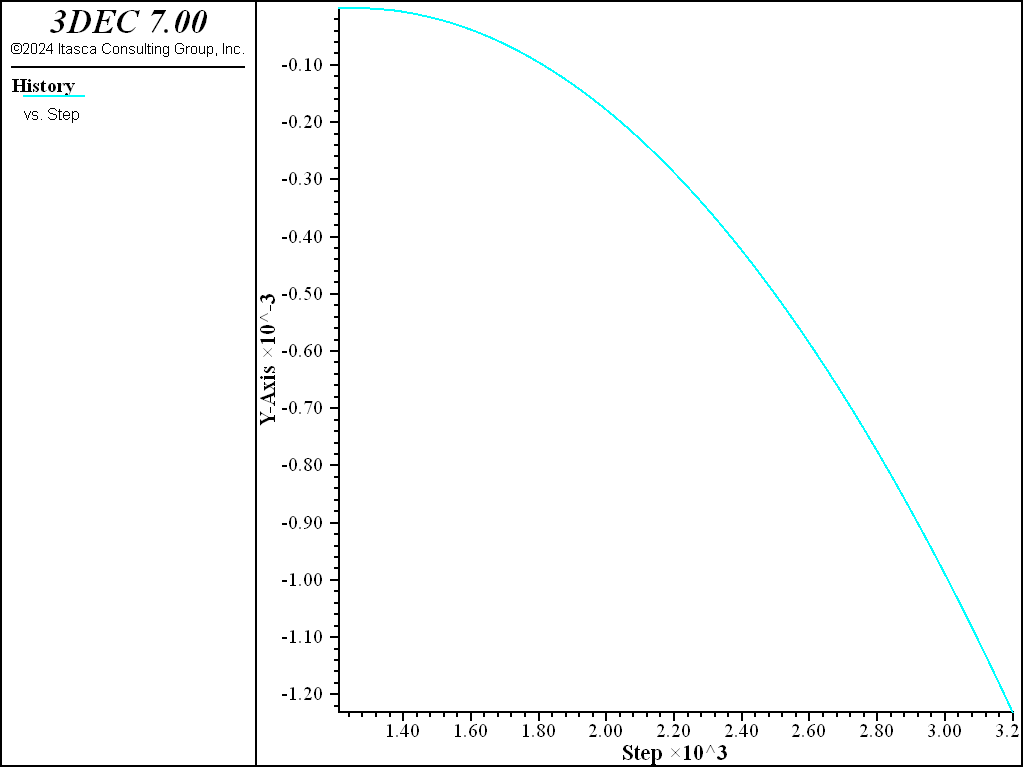Structural Liner in Jointed Tunnel
Problem Statement
Note
To view this project in 3DEC, use the menu command . Choose “BlockSel/ Liner/ JointedTunnel” and select “liner.prj” to load. The data file used is shown at the end of this example.
This is an example showing the application of a structural liner in the inside of a square tunnel. The geometry of the tunnel is shown in Figure 1. The block in the roof of the tunnel will fall if the tensile strength in the horizontal joint above it is not sufficient to support its weight. The model is used to simulate a 20 cm-thick concrete liner. The properties of the liner are
| Young’s modulus | 15 GPa |
| Poisson’s ratio | 0.15 |
| thickness | 0.2 m |
| friction between liner and rock | 60^o |
| cohesion between liner and rock | 0.5 MPa |
| tensile limit of contact between liner and rock | 0.3 MPa |
| normal stiffness of contact | 1 GN/m |
| shear stiffness of contact | 1 GN/m |
The input commands for this example are listed in liner.dat. Figure 2 shows the vertical displacement history of the roof block with no liner in place. The block is free to fall in this case.
The liner is installed using the structure liner create command as shown in the data file. Note the use of the tolerance keyword and the value of 1.0e-4.
This is necessary because the blocks will have moved slightly during stress initialization. The tolerance value ensures that liner nodes will connect to each other if they are created within the specified distance.
Figure 3 shows the vertical displacement history of the unstable block with the concrete liner in place. It is clear that the liner is successful in preventing the rock fall. Moments that develop in the liner are shown in Figure 4.
Data File
liner.dat
model new
model random 10000
model large-strain on
;
; Structural Liner Example Problem
;
block create brick -1 1 -1 1 -1 1
block cut joint-set dip-direction=180 dip=0 origin 0.0, 0.0, 0.5
block hide range plane dip 0 dip-direction 180 origin 0.0, 0.0, 0.5 above
block cut joint-set dip-direction=180 dip=0 origin 0.0, 0.0, 0.3
block hide range plane dip 0 dip-direction 180 origin 0.0, 0.0, 0.3 below
block cut joint-set dip=65 dip-direction=90 origin .24, 0.0, 0.3
block cut joint-set dip=65 dip-direction=270 origin -.24, 0.0, 0.3
block hide off
block group 'rock'
block cut tunnel group 'exc' radial &
face-1 -.3 -1.5 -.3 -.3 -1.5 .3 &
.3 -1.5 .3 .3 -1.5 -.3 &
face-2 -.3 1.5 -.3 -.3 1.5 .3 &
.3 1.5 .3 .3 1.5 -.3
;
block zone generate edgelength .2
block face group 'surface' range group-int 'rock' 'exc'
block delete range group 'exc'
block zone cmodel assign el
block zone prop dens 2000 bulk = 1e9 shear = .7e9
block contact jmodel assign mohr
block contact prop stiffness-shear 1e11 stiffness-normal 1e11
block contact prop fric 100 coh 1e20 tens 1e20
block contact material-table default prop stiffness-shear 1e11 stiffness-normal 1e11
; apply gravity load
model grav 0 0 -10
block gridpoint apply vel-x=0.0 range pos-x -1.0
block gridpoint apply vel-x=0.0 range pos-x 1.0
block gridpoint apply vel-y=0.0 range pos-y -1.0
block gridpoint apply vel-y=0.0 range pos-y 1.0
block gridpoint apply vel-z=0.0 range pos-z -1.0
;
block hist dis-z pos 0 0 0.3
;
model cyc 1200
model save 'liner1'
; reduce tensile strength of horizontal joint
block contact prop tens = 0
block gridpoint ini disp 0 0 0
his delete
block hist dis-z pos 0 0 0.3
model cycle 2000
model save 'liner1b'
===========================================
; now run with tunnel liner
model rest 'liner1'
; reduce tensile strength of horizontal joint
block contact prop tens = 0
block gridpoint ini disp 0 0 0
his delete
block hist dis-z pos 0 0 0.3
struct liner create by-block-face tolerance 1e-4 range group 'surface' pos-z 0.295 0.305
struct liner prop coupling-fric-shear 60 coupling-coh-shear .5e6 ...
coupling-stiffness-normal 1e9 coupling-stiffness-shear 1e9
struct liner prop isotropic 15e9 .15 thick .20 coupling-yield-normal .3e6
model step 5000
model save 'liner2'
| Was this helpful? ... | 3DEC © 2019, Itasca | Updated: Feb 25, 2024 |




